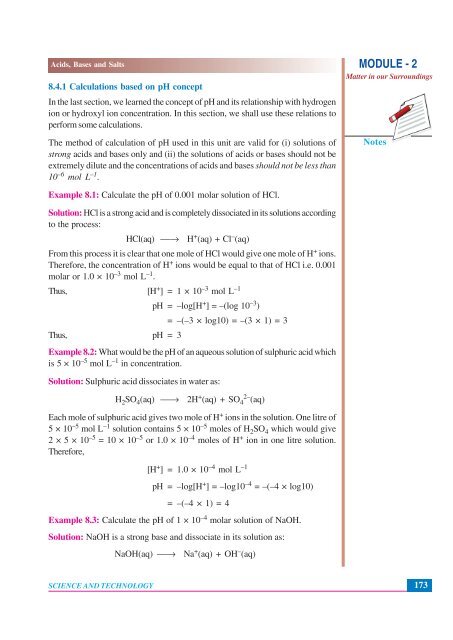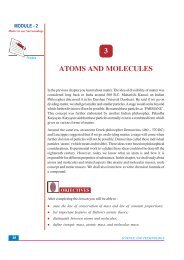8. Acids, Bases and Salts (41.1 MB)
8. Acids, Bases and Salts (41.1 MB)
8. Acids, Bases and Salts (41.1 MB)
Create successful ePaper yourself
Turn your PDF publications into a flip-book with our unique Google optimized e-Paper software.
<strong>Acids</strong>, <strong>Bases</strong> <strong>and</strong> <strong>Salts</strong><br />
<strong>8.</strong>4.1 Calculations based on pH concept<br />
In the last section, we learned the concept of pH <strong>and</strong> its relationship with hydrogen<br />
ion or hydroxyl ion concentration. In this section, we shall use these relations to<br />
perform some calculations.<br />
The method of calculation of pH used in this unit are valid for (i) solutions of<br />
strong acids <strong>and</strong> bases only <strong>and</strong> (ii) the solutions of acids or bases should not be<br />
extremely dilute <strong>and</strong> the concentrations of acids <strong>and</strong> bases should not be less than<br />
10 –6 mol L –1 .<br />
MODULE - 2<br />
Matter in our Surroundings<br />
Notes<br />
Example <strong>8.</strong>1: Calculate the pH of 0.001 molar solution of HCl.<br />
Solution: HCl is a strong acid <strong>and</strong> is completely dissociated in its solutions according<br />
to the process:<br />
HCl(aq) ⎯→ H + (aq) + Cl – (aq)<br />
From this process it is clear that one mole of HCl would give one mole of H + ions.<br />
Therefore, the concentration of H + ions would be equal to that of HCl i.e. 0.001<br />
molar or 1.0 × 10 –3 mol L –1 .<br />
Thus, [H + ] = 1 × 10 –3 mol L –1<br />
pH = –log[H + ] = –(log 10 –3 )<br />
= –(–3 × log10) = –(3 × 1) = 3<br />
Thus, pH = 3<br />
Example <strong>8.</strong>2: What would be the pH of an aqueous solution of sulphuric acid which<br />
is 5 × 10 –5 mol L –1 in concentration.<br />
Solution: Sulphuric acid dissociates in water as:<br />
H 2 SO 4 (aq) ⎯→<br />
2H + (aq) + SO 4 2– (aq)<br />
Each mole of sulphuric acid gives two mole of H + ions in the solution. One litre of<br />
5 × 10 –5 mol L –1 solution contains 5 × 10 –5 moles of H 2 SO 4 which would give<br />
2 × 5 × 10 –5 = 10 × 10 –5 or 1.0 × 10 –4 moles of H + ion in one litre solution.<br />
Therefore,<br />
[H + ] = 1.0 × 10 –4 mol L –1<br />
pH = –log[H + ] = –log10 –4 = –(–4 × log10)<br />
= –(–4 × 1) = 4<br />
Example <strong>8.</strong>3: Calculate the pH of 1 × 10 –4 molar solution of NaOH.<br />
Solution: NaOH is a strong base <strong>and</strong> dissociate in its solution as:<br />
NaOH(aq) ⎯→<br />
Na + (aq) + OH – (aq)<br />
SCIENCE AND TECHNOLOGY<br />
173
















